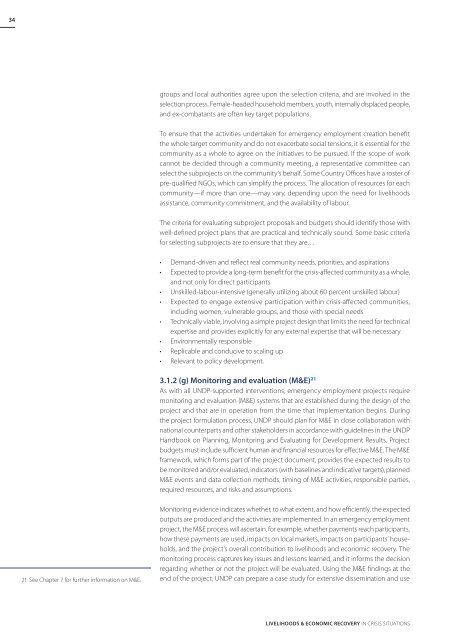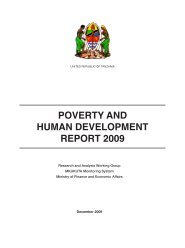Download PDF (4.08 MB) - ReliefWeb
Download PDF (4.08 MB) - ReliefWeb
Download PDF (4.08 MB) - ReliefWeb
Create successful ePaper yourself
Turn your PDF publications into a flip-book with our unique Google optimized e-Paper software.
34<br />
groups and local authorities agree upon the selection criteria, and are involved in the<br />
selection process. Female-headed household members, youth, internally displaced people,<br />
and ex-combatants are often key target populations.<br />
To ensure that the activities undertaken for emergency employment creation benefit<br />
the whole target community and do not exacerbate social tensions, it is essential for the<br />
community as a whole to agree on the initiatives to be pursued. If the scope of work<br />
cannot be decided through a community meeting, a representative committee can<br />
select the subprojects on the community’s behalf. Some Country Offices have a roster of<br />
pre-qualified NGOs, which can simplify the process. The allocation of resources for each<br />
community—if more than one—may vary, depending upon the need for livelihoods<br />
assistance, community commitment, and the availability of labour.<br />
The criteria for evaluating subproject proposals and budgets should identify those with<br />
well-defined project plans that are practical and technically sound. Some basic criteria<br />
for selecting subprojects are to ensure that they are…<br />
• Demand-driven and reflect real community needs, priorities, and aspirations<br />
• Expected to provide a long-term benefit for the crisis-affected community as a whole,<br />
and not only for direct participants<br />
• Unskilled-labour-intensive (generally utilizing about 60 percent unskilled labour)<br />
• Expected to engage extensive participation within crisis-affected communities,<br />
including women, vulnerable groups, and those with special needs<br />
• Technically viable, involving a simple project design that limits the need for technical<br />
expertise and provides explicitly for any external expertise that will be necessary<br />
• Environmentally responsible<br />
• Replicable and conducive to scaling up<br />
• Relevant to policy development.<br />
3.1.2 (g) Monitoring and evaluation (M&E) 21<br />
As with all UNDP-supported interventions, emergency employment projects require<br />
monitoring and evaluation (M&E) systems that are established during the design of the<br />
project and that are in operation from the time that implementation begins. During<br />
the project formulation process, UNDP should plan for M&E in close collaboration with<br />
national counterparts and other stakeholders in accordance with guidelines in the UNDP<br />
Handbook on Planning, Monitoring and Evaluating for Development Results. Project<br />
budgets must include sufficient human and financial resources for effective M&E. The M&E<br />
framework, which forms part of the project document, provides the expected results to<br />
be monitored and/or evaluated, indicators (with baselines and indicative targets), planned<br />
M&E events and data collection methods, timing of M&E activities, responsible parties,<br />
required resources, and risks and assumptions.<br />
21 See Chapter 7 for further information on M&E.<br />
Monitoring evidence indicates whether, to what extent, and how efficiently, the expected<br />
outputs are produced and the activities are implemented. In an emergency employment<br />
project, the M&E process will ascertain, for example, whether payments reach participants,<br />
how these payments are used, impacts on local markets, impacts on participants’ households,<br />
and the project’s overall contribution to livelihoods and economic recovery. The<br />
monitoring process captures key issues and lessons learned, and it informs the decision<br />
regarding whether or not the project will be evaluated. Using the M&E findings at the<br />
end of the project, UNDP can prepare a case study for extensive dissemination and use<br />
Livelihoods & Economic Recovery in Crisis Situations





